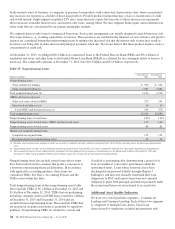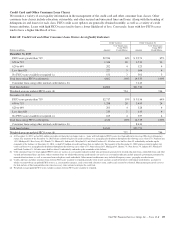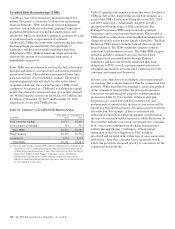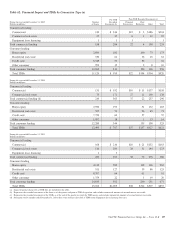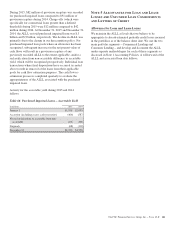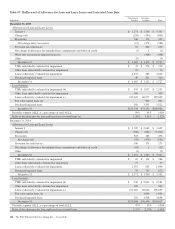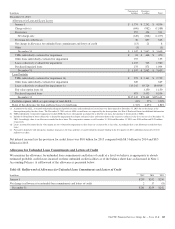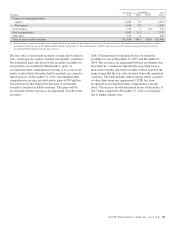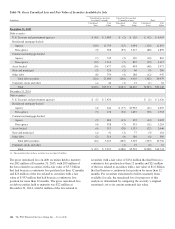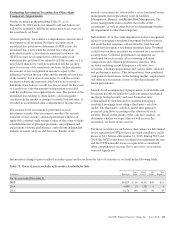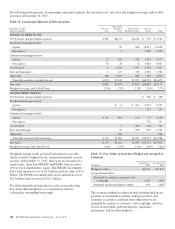PNC Bank 2015 Annual Report Download - page 156
Download and view the complete annual report
Please find page 156 of the 2015 PNC Bank annual report below. You can navigate through the pages in the report by either clicking on the pages listed below, or by using the keyword search tool below to find specific information within the annual report.
TDRs may result in charge-offs and interest income not being
recognized. The amount of principal balance charged off at or
around the time of modification for the twelve months ended
December 31, 2015 was not material. A financial effect of rate
reduction TDRs is that interest income is not recognized for
the difference between the original contractual interest rate
terms and the restructured terms. Interest income not
recognized that otherwise would have been earned in the
twelve months ended December 31, 2015 and 2014, related to
all commercial TDRs and consumer TDRs, was not material.
After a loan is determined to be a TDR, we continue to track
its performance under its most recent restructured terms. In
Table 63, we consider a TDR to have subsequently defaulted
when it becomes 60 days past due after the most recent date
the loan was restructured. The following table presents the
recorded investment of loans that both (i) were classified as
TDRs or were subsequently modified during each 12-month
period preceding January 1, 2015, 2014, and 2013
respectively, and (ii) subsequently defaulted during these
reporting periods.
Table 63: TDRs that were Modified in the Past Twelve
Months which have Subsequently Defaulted
During the year ended
December 31, 2015
Dollars in millions Number of Contracts Recorded Investment
Commercial lending
Commercial 23 $ 9
Commercial real estate 13 13
Equipment lease financing 1 1
Total commercial lending 37 23
Consumer lending
Home equity 458 26
Residential real estate 150 22
Credit card 3,045 24
Other consumer 167 1
Total consumer lending 3,820 73
Total TDRs 3,857 $ 96
During the year ended
December 31, 2014
Dollars in millions Number of Contracts Recorded Investment
Commercial lending
Commercial 38 $ 26
Commercial real estate 43 80
Total commercial lending (a) 81 106
Consumer lending
Home equity 400 21
Residential real estate 155 24
Credit card 3,397 27
Other consumer 132 1
Total consumer lending 4,084 73
Total TDRs 4,165 $179
During the year ended
December 31, 2013
Dollars in millions Number of Contracts Recorded Investment
Commercial lending
Commercial 67 $ 47
Commercial real estate 38 59
Total commercial lending (a) 105 106
Consumer lending
Home equity 592 39
Residential real estate 255 35
Credit card 4,598 34
Other consumer 249 4
Total consumer lending 5,694 112
Total TDRs 5,799 $218
(a) During the twelve months ended December 31, 2014 and 2013, there were no loans
classified as TDRs in the Equipment lease financing loan class that have
subsequently defaulted.
The impact to the ALLL for commercial lending TDRs is the
effect of moving to the specific reserve methodology from the
quantitative reserve methodology, for those loans that were
not already classified as nonaccrual. There is generally an
impact to the ALLL as a result of the concession made, which
generally results in a reduction of expected future cash flows.
The decline in expected future cash flows, consideration of
collateral value, and/or the application of a present value
discount rate, when compared to the recorded investment,
results in either an increased ALLL or a charge-off. As TDRs
are individually evaluated under the specific reserve
methodology, which builds in expectations of future
performance, subsequent defaults generally do not
significantly impact the ALLL.
For consumer lending TDRs, except TDRs resulting from
borrowers that have been discharged from personal liability
through Chapter 7 bankruptcy and have not formally
reaffirmed their loan obligations to PNC as discussed in
Note 1 Accounting Policies under the Allowance for Loans
and Lease Losses section, the ALLL is calculated using a
discounted cash flow model, which leverages subsequent
default, prepayment, and severity rate assumptions based upon
historically observed data. Similar to the commercial lending
specific reserve methodology, the reduced expected cash
flows resulting from the concessions granted impact the
consumer lending ALLL. The decline in expected cash flows
due to the application of a present value discount rate or the
consideration of collateral value, when compared to the
recorded investment, results in either an increased ALLL or a
charge-off. Loans where a borrower has been discharged from
personal liability in bankruptcy and has not formally
reaffirmed its loan obligation to PNC are charged off to
collateral value less costs to sell, and any associated allowance
at the time of charge-off is reduced to zero.
138 The PNC Financial Services Group, Inc. – Form 10-K


